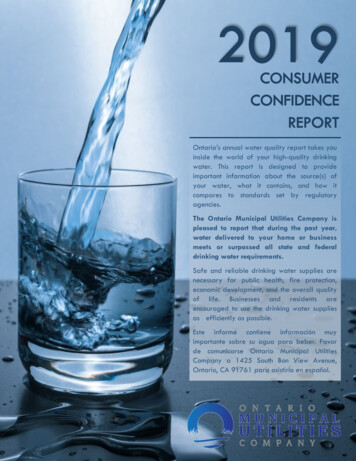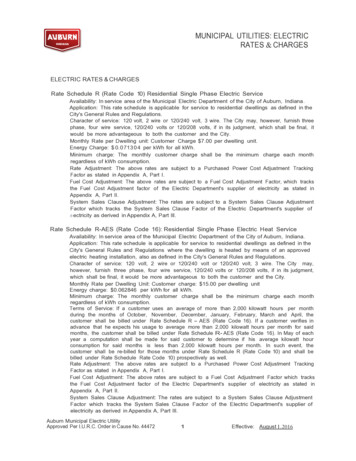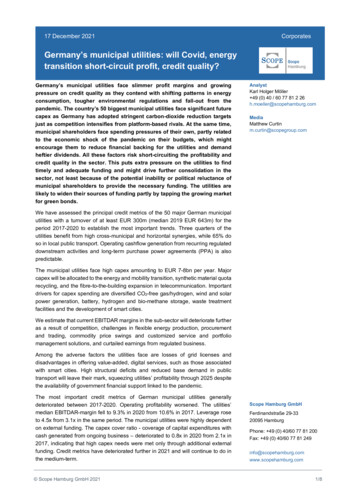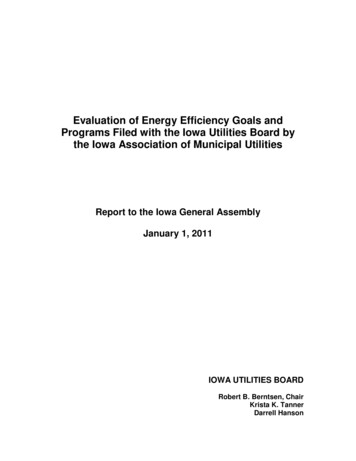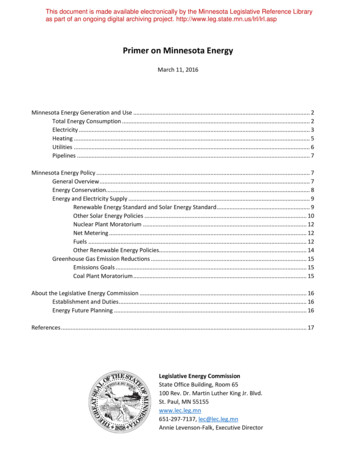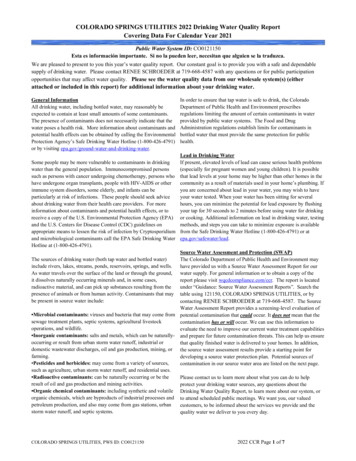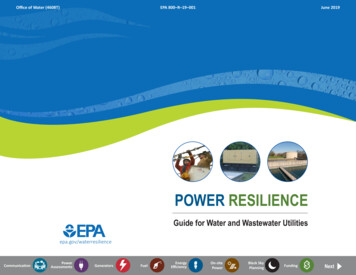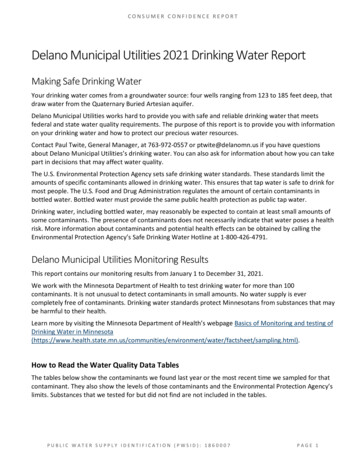
Transcription
CONSUMER CONFIDENCE REPORTDelano Municipal Utilities 2021 Drinking Water ReportMaking Safe Drinking WaterYour drinking water comes from a groundwater source: four wells ranging from 123 to 185 feet deep, thatdraw water from the Quaternary Buried Artesian aquifer.Delano Municipal Utilities works hard to provide you with safe and reliable drinking water that meetsfederal and state water quality requirements. The purpose of this report is to provide you with informationon your drinking water and how to protect our precious water resources.Contact Paul Twite, General Manager, at 763‐972‐0557 or ptwite@delanomn.us if you have questionsabout Delano Municipal Utilities’s drinking water. You can also ask for information about how you can takepart in decisions that may affect water quality.The U.S. Environmental Protection Agency sets safe drinking water standards. These standards limit theamounts of specific contaminants allowed in drinking water. This ensures that tap water is safe to drink formost people. The U.S. Food and Drug Administration regulates the amount of certain contaminants inbottled water. Bottled water must provide the same public health protection as public tap water.Drinking water, including bottled water, may reasonably be expected to contain at least small amounts ofsome contaminants. The presence of contaminants does not necessarily indicate that water poses a healthrisk. More information about contaminants and potential health effects can be obtained by calling theEnvironmental Protection Agency’s Safe Drinking Water Hotline at 1‐800‐426‐4791.Delano Municipal Utilities Monitoring ResultsThis report contains our monitoring results from January 1 to December 31, 2021.We work with the Minnesota Department of Health to test drinking water for more than 100contaminants. It is not unusual to detect contaminants in small amounts. No water supply is evercompletely free of contaminants. Drinking water standards protect Minnesotans from substances that maybe harmful to their health.Learn more by visiting the Minnesota Department of Health’s webpage Basics of Monitoring and testing ofDrinking Water in es/environment/water/factsheet/sampling.html).How to Read the Water Quality Data TablesThe tables below show the contaminants we found last year or the most recent time we sampled for thatcontaminant. They also show the levels of those contaminants and the Environmental Protection Agency’slimits. Substances that we tested for but did not find are not included in the tables.PUBLIC WATER SUPPLY IDENTIFICATION (PWSID): 1860007PAGE 1
CONSUMER CONFIDENCE REPORTWe sample for some contaminants less than once a year because their levels in water are not expected tochange from year to year. If we found any of these contaminants the last time we sampled for them, weincluded them in the tables below with the detection date.We may have done additional monitoring for contaminants that are not included in the Safe DrinkingWater Act. To request a copy of these results, call the Minnesota Department of Health at 651‐201‐4700between 8:00 a.m. and 4:30 p.m., Monday through Friday.Some contaminants are monitored regularly throughout the year, and rolling (or moving) annual averagesare used to manage compliance. Because of this averaging, there are times where the Range of DetectedTest Results for the calendar year is lower than the Highest Average or Highest Single Test Result, becauseit occurred in the previous calendar year.Definitions AL (Action Level): The concentration of a contaminant which, if exceeded, triggers treatment orother requirements which a water system must follow.EPA: Environmental Protection AgencyMCL (Maximum contaminant level): The highest level of a contaminant that is allowed in drinkingwater. MCLs are set as close to the MCLGs as feasible using the best available treatmenttechnology.MCLG (Maximum contaminant level goal): The level of a contaminant in drinking water belowwhich there is no known or expected risk to health. MCLGs allow for a margin of safety.MRDL (Maximum residual disinfectant level): The highest level of a disinfectant allowed indrinking water. There is convincing evidence that addition of a disinfectant is necessary for controlof microbial contaminants.MRDLG (Maximum residual disinfectant level goal): The level of a drinking water disinfectantbelow which there is no known or expected risk to health. MRDLGs do not reflect the benefits ofthe use of disinfectants to control microbial contaminants.N/A (Not applicable): Does not apply.ppb (parts per billion): One part per billion in water is like one drop in one billion drops of water, orabout one drop in a swimming pool. ppb is the same as micrograms per liter (μg/l).ppm (parts per million): One part per million is like one drop in one million drops of water, orabout one cup in a swimming pool. ppm is the same as milligrams per liter (mg/l).PWSID: Public water system identification.PUBLIC WATER SUPPLY IDENTIFICATION (PWSID): 1860007PAGE 2
CONSUMER CONFIDENCE REPORTMonitoring Results – Regulated SubstancesLEAD AND COPPER – Tested at customer taps.Contaminant (Date, ifsampled in vel90% ofResults WereLess ThanNumberofHomeswithHighLevelsViolationTypical SourcesLead0 ppb90% ofhomesless than15 ppb1.6 ppb0 out of20NOCorrosion ofhouseholdplumbing.Copper0 ppm90% ofhomesless than1.3 ppm0.88 ppm0 out of20NOCorrosion ofhouseholdplumbing.INORGANIC & ORGANIC CONTAMINANTS – Tested in drinking water.Contaminant(Date, if sampledin previous year)Arsenic(01/07/20)EPA’sIdealGoal(MCLG)0 ppbEPA’sLimit(MCL)10.4ppbHighestAverage orHighestSingle TestResultRange ofDetectedTest ResultsViolationTypical Sources1.3 ppbN/ANOErosion of naturaldeposits; Runoff fromorchards; Runoff fromglass and electronicsproduction wastes.PUBLIC WATER SUPPLY IDENTIFICATION (PWSID): 1860007PAGE 3
CONSUMER CONFIDENCE REPORTCONTAMINANTS RELATED TO DISINFECTION – Tested in drinking water.EPA’s IdealGoal (MCLGor MRDLG)EPA’sLimit(MCL orMRDL)HighestAverage orHighestSingle TestResultRange ofDetectedTest ResultsViolationTypical SourcesTotalTrihalomethanes(TTHMs)N/A80 ppb10.7 ppbN/ANOBy‐product ofdrinking waterdisinfection.Total HaloaceticAcids (HAA)N/A60 ppb12.3 ppbN/ANOBy‐product ofdrinking waterdisinfection.4.0 ppm4.0 ppm0.59 ppm0.34 ‐ 1.03ppmNOWater additiveused to controlmicrobes.Substance (Date, ifsampled in previousyear)Total ChlorineTotal HAA refers to HAA5OTHER SUBSTANCES – Tested in drinking water.Substance (Date,if sampled inprevious year)FluorideEPA’sIdeal Goal(MCLG)EPA’sLimit(MCL)HighestAverage orHighest SingleTest Result4.0 ppm4.0 ppm0.53 ppmRange ofDetectedTest Results0.43 ‐ 0.63ppmViolationTypical SourcesNOErosion of naturaldeposits; Wateradditive to promotestrong teeth.Potential Health Effects and Corrective Actions (If Applicable)Fluoride: If your drinking water fluoride levels are below the optimal concentration range of 0.5 to 0.9 ppm,please talk with your dentist about how you can protect your teeth and your family's teeth from tooth decayand cavities. For more information, visit: MDH Drinking Water ities/environment/water/com/fluoride.html). Fluoride is nature'scavity fighter, with small amounts present naturally in many drinking water sources. There is an overwhelmingweight of credible, peer‐reviewed, scientific evidence that fluoridation reduces tooth decay and cavities inchildren and adults, even when there is availability of fluoride from other sources, such as fluoride toothpasteand mouth rinses. Since studies show that optimal fluoride levels in drinking water benefit public health,municipal community water systems adjust the level of fluoride in the water to an optimal concentrationbetween 0.5 to 0.9 parts per million (ppm) to protect your teeth. Fluoride levels below 2.0 ppm are notexpected to increase the risk of a cosmetic condition known as enamel fluorosis.PUBLIC WATER SUPPLY IDENTIFICATION (PWSID): 1860007PAGE 4
CONSUMER CONFIDENCE REPORTSome People Are More Vulnerable to Contaminants in Drinking WaterSome people may be more vulnerable to contaminants in drinking water than the general population.Immuno‐compromised persons such as persons with cancer undergoing chemotherapy, persons who haveundergone organ transplants, people with HIV/AIDS or other immune system disorders, some elderly, andinfants can be particularly at risk from infections. The developing fetus and therefore pregnant womenmay also be more vulnerable to contaminants in drinking water. These people or their caregivers shouldseek advice about drinking water from their health care providers. EPA/Centers for Disease Control (CDC)guidelines on appropriate means to lessen the risk of infection by Cryptosporidium and other microbialcontaminants are available from the Safe Drinking Water Hotline at 1‐800‐426‐4791.Learn More about Your Drinking WaterDrinking Water SourcesMinnesota’s primary drinking water sources are groundwater and surface water. Groundwater is the waterfound in aquifers beneath the surface of the land. Groundwater supplies 75 percent of Minnesota’sdrinking water. Surface water is the water in lakes, rivers, and streams above the surface of the land.Surface water supplies 25 percent of Minnesota’s drinking water.Contaminants can get in drinking water sources from the natural environment and from people’s dailyactivities. There are five main types of contaminants in drinking water sources. Microbial contaminants, such as viruses, bacteria, and parasites. Sources include sewage treatmentplants, septic systems, agricultural livestock operations, pets, and wildlife.Inorganic contaminants include salts and metals from natural sources (e.g. rock and soil), oil and gasproduction, mining and farming operations, urban stormwater runoff, and wastewater discharges.Pesticides and herbicides are chemicals used to reduce or kill unwanted plants and pests. Sourcesinclude agriculture, urban stormwater runoff, and commercial and residential properties.Organic chemical contaminants include synthetic and volatile organic compounds. Sources includeindustrial processes and petroleum production, gas stations, urban stormwater runoff, and septicsystems.Radioactive contaminants such as radium, thorium, and uranium isotopes come from natural sources(e.g. radon gas from soils and rock), mining operations, and oil and gas production.The Minnesota Department of Health provides information about your drinking water source(s) in a sourcewater assessment, including: How Delano Municipal Utilities is protecting your drinking water source(s);Nearby threats to your drinking water sources;How easily water and pollution can move from the surface of the land into drinking water sources,based on natural geology and the way wells are constructed.Find your source water assessment at Source Water ties/environment/water/swp/swa) or call 651‐201‐4700between 8:00 a.m. and 4:30 p.m., Monday through Friday.PUBLIC WATER SUPPLY IDENTIFICATION (PWSID): 1860007PAGE 5
CONSUMER CONFIDENCE REPORTLead in Drinking WaterYou may be in contact with lead through paint, water, dust, soil, food, hobbies, or your job. Coming incontact with lead can cause serious health problems for everyone. There is no safe level of lead. Babies,children under six years, and pregnant women are at the highest risk.Lead is rarely in a drinking water source, but it can get in your drinking water as it passes through leadservice lines and your household plumbing system. Delano Municipal Utilities is responsible for providinghigh quality drinking water, but it cannot control the plumbing materials used in private buildings.Read below to learn how you can protect yourself from lead in drinking water.1.Let the water run for 30‐60 seconds before using it for drinking or cooking if the water has not beenturned on in over six hours. If you have a lead service line, you may need to let the water run longer. Aservice line is the underground pipe that brings water from the main water pipe under the street toyour home. 2.3.Use cold water for drinking, making food, and making baby formula. Hot water releases more leadfrom pipes than cold water.Test your water. In most cases, letting the water run and using cold water for drinking and cookingshould keep lead levels low in your drinking water. If you are still concerned about lead, arrange witha laboratory to test your tap water. Testing your water is important if young children or pregnantwomen drink your tap water. 4.You can find out if you have a lead service line by contacting your public water system, or you cancheck by following the steps at: d‐lead‐pipes‐in‐your‐homeThe only way to know if lead has been reduced by letting it run is to check with a test. If lettingthe water run does not reduce lead, consider other options to reduce your exposure.Contact a Minnesota Department of Health accredited laboratory to get a sample container andinstructions on how to submit a sample:Environmental Laboratory Accreditation /accreditedlabs/labsearch.seam)The Minnesota Department of Health can help you understand your test results.Treat your water if a test shows your water has high levels of lead after you let the water run. Read about water treatment units:Point‐of‐Use Water Treatment Units for Lead es/environment/water/factsheet/poulead.html)Learn more: Visit Lead in Drinking nvironment/water/contaminants/lead.html)Visit Basic Information about Lead in Drinking Water (http://www.epa.gov/safewater/lead)Call the EPA Safe Drinking Water Hotline at 1‐800‐426‐4791.To learn about how to reduce yourcontact with lead from sources other than your drinking water, visit Common /environment/lead/fs/common.html).PUBLIC WATER SUPPLY IDENTIFICATION (PWSID): 1860007PAGE 6
service lines and your household plumbing system. Delano Municipal Utilities is responsible for providing high quality drinking water, but it cannot control the plumbing materials used in private buildings. Read below to learn how you can protect yourself from lead in drinking water. 1.


